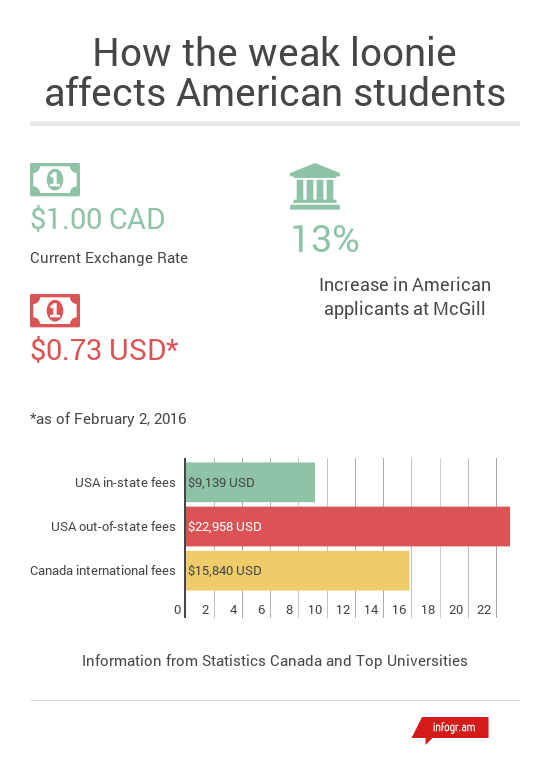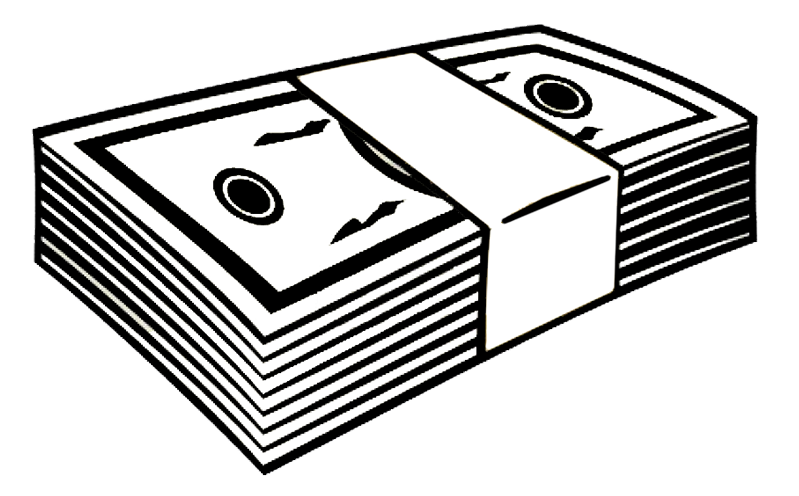While Canadians are spending more for less as a result of the weak loonie, Americans attending school north of the border could save big on tuition, rent, and food.
International students in Canada can usually pay tuition in their local currency, but due to the low exchange rate of the Canadian dollar, foreign students could save hundreds—if not thousands—on fees.
As of Feb. 3, the Canadian dollar equaled $0.73 U.S. dollars (USD). International students paid an average of $22,000 in Canadian dollars (CAN) in tuition fees per year, according to Statistics Canada.
Convert that figure into U.S. dollars, and it could cost the average American international student $15,840 USD.
Take into consideration living expenses such as rent, transportation, and food costs, and American students could save even more.
“It’s an advantage for me because I have to pay rent and it means my rent price is down and my tuition price is down too,” said Jake McKeown, a communications and Latin American studies student at Carleton University who is from Philadelphia.
“I get a stipend of $100 [USD] each month because I’m the son of an army veteran so the money goes further than usual because of the low Canadian dollar,” he said.
McKeown said he paid approximately $23,000 CAD this year for tuition, which totaled $21,000 USD at the time he paid. If he converts that figure using Feb. 3’s exchange rate, he’d only have to pay $16,790 USD.
He mentioned his rent is roughly $150 cheaper per month as well.
Canada can be a desirable place for American students due to relatively high tuition fees south of the border.
McKeown said tuition at a lesser-known university such as Bloomsburg University in Pennsylvania can cost about $6,000-$7,000 USD per year. A state university such as Penn State can cost about $34,000 USD per year, including tuition with room and board.
Out-of-state universities such as the University of Rhode Island would cost $46,000 USD for a year, he said.
According to Kathleen Massey, director of enrolment services at McGill University, there’s been a 13 per cent spike in American applications to the school’s undergraduate programs for next year.
At the University of British Columbia, international undergraduate student fees range from $30,359 to $36,519, according to the director of the school’s international student initiative Karen McKellin.
McKellin noted, however, that international students often come to Canada for the value of the degree as opposed to saving money.
“International students are not really looking for a bargain. They want to know they are investing in something of lasting value and of very high quality, even when a temporary exchange rate makes that a little more affordable for a short term,” she said.
Bruce Winer, Carleton’s assistant vice-president of institutional research and planning, said he hasn’t noticed a jump in international student enrolment.
“Not really this year,” Winer said. “[But] Carleton does attract a significant number of international students. At the undergraduate level, Carleton has the third largest proportion of international undergraduate students in Ontario, after [the University of Toronto] and [University of] Waterloo.”
Thirteen per cent of first-year students arriving at Carleton in fall 2015 came from outside of Canada, according to Winer.
Like McKellin, Winer said there is more than just the money factor to entice American students to come to Canada.
Winer said while the change in currency value “doesn’t appear to be a direct relationship that overrides other factors,” Americans get more bang for their buck for post-secondary education in Canada.
“Canadian universities offer U.S. students a significant cost advantage over U.S. institutions given the level of quality in Canadian universities and the price at equivalent U.S. institutions,” he said.
For McKeown, the cost of living is cheaper in Canada, too. In Philadelphia, he said it can cost as much as $800 USD per month for a one bedroom apartment. In Ottawa, McKeown is paying $550 USD, which he said is “not a bargain, but it’s nice.”







